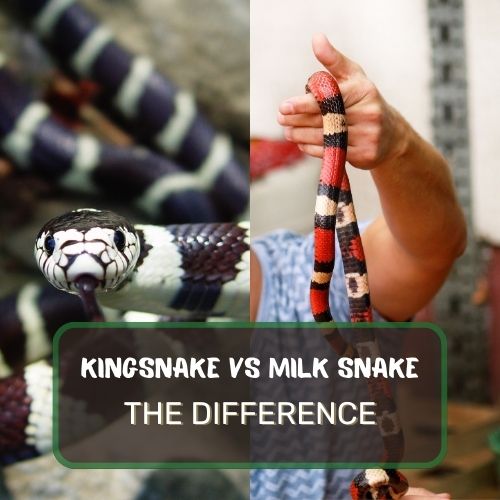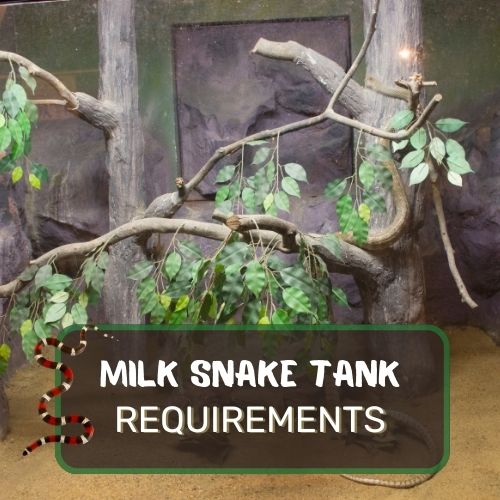Ever found yourself scratching your head, trying to figure out the difference between a king snake and a milk snake? You’re not alone! These slithering species often leave many perplexed with their strikingly similar looks. But fret not!
King snakes and milk snakes, both non-venomous, can be distinguished primarily by their patterns and regions. King snakes boast broad bands of red, black, and white or yellow, while milk snakes display narrower red bands with black borders separated by white or yellow.
Dive into this article, where we’ll unravel the mysteries surrounding these snakes, from their physical appearances and unique behaviors to their habitats and, yes, the big question about venom.
We’ll even tackle those burning FAQs you’ve been itching to ask. Ready to become a snake savant? Let’s slither in!

Table of Contents
The Basics: Quick Facts and Overview
Two species that often make folks scratch their heads in confusion are the king snake and the milk snake.
Why?
They look deceptively similar, and distinguishing between them can sometimes feel like you’re solving a tricky puzzle. But worry not! We’re about to unravel this mystery.
Where They Are Commonly Found
The king snake, as regal as its name suggests, primarily claims the North American region as its stomping ground. From forests to grasslands, these snakes have adapted to a variety of habitats, spanning from the east coast all the way to the west.
On the flip side, milk snakes, though also found in North America, have a broader range. They’re the jet-setters of the snake world, spanning from Canada down to Central America. They’ve certainly got the travel bug!
Their General Appearance at First Glance
At first glance, both these species might seem like long-lost twins. They both exhibit striking bands that could give top designers a run for their money. However, with a keen eye, you’ll notice subtle differences.
King snakes often come with alternating bands of red, black, and yellow or white. Think of them as wearing a snazzy striped sweater. These bands are often broad and vivid, making them quite the showstopper.
Milk snakes, while they also flaunt bands, have a slightly different palette. Their bands are usually red with black borders, often sandwiched between white or yellow segments. It’s like they’re donning a chic, color-blocked outfit.
In the end, while they may seem similar, understanding the difference between king snake and milk snake is all about the nuances. Remember those little details, and you’ll never mix them up again!

Physical Appearance: More Than Just Scales
Hold on to your hats, because when it comes to the physical appearance of these two snakes, there’s so much more than meets the eye!
The Size of Both Snakes
Now, for a quick size check. King snakes typically range between 3 to 6 feet in length. They’re like the “average Joes” of the snake world – not too short, not too long, just right.
On the other hand, milk snakes tend to be a bit more modest in size, generally measuring up between 2 to 5 feet. It’s like comparing a sedan to a compact car; both get you where you need to go, but there’s a slight difference in length!
The Color Patterns Involved
We touched on this earlier, but let’s paint a clearer picture. King snakes wear their bold bands of red, black, and white or yellow proudly. It’s like they’re flaunting designer wear.
Meanwhile, milk snakes prefer to play with shades of red bands bordered with black, often separated by white or yellow segments. It’s a more color-blocked and coordinated ensemble.
Shape and Design of the Head, Eyes, and Body
When it comes to the head, the king snake has a slightly broader, more robust noggin compared to the more tapered head of the milk snake.
Their eyes?
King snakes have round, expressive peepers, while milk snakes display a slightly more elliptical shape. It’s like comparing round sunglasses to aviators; both are stylish, but each has its unique flair.
Any Distinguishing Features to Help Identify Them Quickly
For a rapid ID check, focus on the bands. If they’re bold, broad, and super defined, you’re likely looking at a king snake. If they seem narrower with black borders, give a nod to the milk snake.
Also, if you get a close look, milk snakes have a unique Y or V shape on their heads. It’s their little signature move!

Behavior and Temperament: Nature’s Personalities
Alright, enough about looks. Let’s dive into their personalities, shall we?
Are they Aggressive or Docile?
Despite their fierce appearance, both snakes are on the docile side. It’s like judging a book by its cover and then realizing it’s a heartwarming story inside. They’re non-venomous and generally mind their business unless provoked.
Unique Behaviors of King Snakes
King snakes have a fascinating behavior – they eat other snakes! Yup, they have a preference for dining on venomous snakes, making them a friend to many. They’re like the brave knights of the snake world, facing dangerous foes to keep the peace.
Unique Behaviors of Milk Snakes
Milk snakes have garnered a reputation as barn visitors. Why? They’ve got a penchant for rodent meals, making them a farmer’s ally. Plus, they’re known to shake their tails when they feel threatened, mimicking the sound of a rattlesnake. Clever, huh?
How Each Species Reacts to Human Interaction
Both species, if encountered in the wild, prefer to flee than engage. King snakes, if cornered, might hiss and strike, but remember, it’s all bark and no bite. Milk snakes, when feeling threatened, might pull off their tail-shaking trick or try to quickly slither away.
The bottom line? These snakes aren’t out to get us. They’re just living their lives, occasionally crossing our paths. Like those fleeting interactions with strangers, where you share a moment, a smile, or even just a passing glance.
So, the next time you come across one, remember to admire from a distance, and let them be.

Habitat and Distribution: Where Do They Slither?
Let’s take a little geographical tour and find out where our scaly friends love to slither.
Natural Habitats for the King Snake
King snakes aren’t too picky about their living conditions. From the lush forests to the dry, rugged deserts, these creatures have adapted to an array of environments.
They’re the kind of guys who can comfortably crash both at a penthouse party in the city and a barn hoedown in the country. Whether it’s under rocks, in the cozy burrows of other animals, or within dense foliage, king snakes know how to pick a prime real estate spot!
Natural Habitats for the Milk Snake
Milk snakes, meanwhile, have a slightly more specific preference. They’re the type who’d rather opt for a quiet countryside retreat than the hustle and bustle of city life. Think woodlands, grasslands, and yes, even farms.
Remember their love for barns? It’s like their version of a weekend getaway cottage. They’re often found curled up beneath logs, rocks, or in the shadows, waiting patiently for their next rodent meal to stroll by.
Geographic Distribution – Where Are They Commonly Found?
Now, for the juicy bit. The king snake predominantly calls North America its home, lounging from the east coast to the west, soaking in the diverse landscapes.
Milk snakes, on the other hand, are slightly more widespread. Starting from Canada, these travelers snake their way down through the United States and even venture into Central America. Talk about wanderlust!
The Type of Environment Each Prefers
To sum it up, king snakes are versatile. They’re adaptable and thrive both in moist woodlands and arid deserts. They’re essentially the jack-of-all-trades in the snake world.
Milk snakes? They lean towards cooler, shaded spots. Grasslands, woodlands, and farms are their top picks. It’s all about that chill, laid-back vibe for them.

Are They Dangerous? Venom and Bite
Now, let’s address the elephant (or should I say, the snake?) in the room. Just how dangerous are these slithering species? Do they have that venomous villain vibe, or are they more like the misunderstood antiheroes of the reptile realm?
Let’s get the lowdown.
Discussing the Venom Factor in King Snakes
Straight up, king snakes? Totally venom-free. Yup, they’re the clean-living, no-nasties type. Even though they have a reputation for munching on other snakes, including the venomous kind, they themselves don’t pack any venomous punch.
Think of them as the pacifists in the snake world, relying more on constriction to subdue their prey rather than venom.
The Truth About Milk Snake Bites
Milk snakes, those barn-loving rodents’ nightmare, are also on the venom-less bandwagon. If they do happen to bite, and that’s a big “if”, it’s more about a show of defense rather than aggression.
It’s kinda like getting a pinch from a toddler – surprising, yes, but not really harmful. Plus, their mimicry of the rattlesnake with their tail-shaking antics is more about putting on a show to scare off potential threats.
Precautionary Measures for Humans
Even though both these species are harmless, it’s always a good mantra to admire from a distance. If you spot one, give it its space. No sudden moves or attempts to handle. Remember, they’re more scared of us giant humans than we are of them.
And as always, when trekking or hiking in areas known for snakes, wear appropriate footwear and remain vigilant.

Final Word
You’ve journeyed through the captivating world of king snakes and milk snakes, unraveling their similarities and distinctions. From physical characteristics to habitats, you now possess the knowledge to identify and appreciate these intriguing reptiles.
Remember, understanding our environment and its inhabitants fosters respect and appreciation. So, next time you’re out exploring, carry this newfound wisdom with you.
Nature awaits your keen observation, and you’re more equipped than ever. Happy exploring!
FAQ
Let’s not dilly-dally and get straight to those burning questions.
How Can You Tell a King Snake?
King snakes flaunt bold bands of red, black, and either white or yellow. They’ve got that broad, slightly more robust head, round eyes, and if you’re still unsure, check for wider bands. It’s like identifying a celebrity by their signature style.
How Can You Tell a Milk Snake?
Milk snakes have a more refined color scheme. Look for red bands with black borders, separated by white or yellow segments. They’ve got a tapered head and, here’s the clincher, a unique Y or V shape on their head. It’s their very own calling card.
How Poisonous is a Milk Snake?
Good news! Milk snakes aren’t poisonous at all. They might put on a good show with their tail shaking, but in the venom department? Zilch. Nada.
What Color are King Snakes?
King snakes are the fashion-forward species with alternating bands of red, black, and either white or yellow. Imagine them walking a reptile runway with those vibrant patterns.
What Does the Underbelly of a Kingsnake Look Like?
The underbelly of a king snake is usually checkered or patterned, often a continuation of the colors from their bands, mostly black and white or yellow. Think of it as their version of a cool graphic tee!




0 Comments